The original structure of Magic—that is, the fact that it was sold in randomized booster packs of one rare, three uncommon, and 9-11 common cards at a price point that represents some portion of the average American weekly allowance for the skinned-knees-and-skateboard set—was planned as an equalizing factor for individualized metagames. But the world was in the process of a connectivity shift in the 1990’s, and the online economy that sprung up by the end of the decade meant that it became much more cost effective to build your deck by purchasing singles from a clearinghouse rather than rely on what you opened from a handful of boosters, particularly when new cards were coming out all the time. Why rely on luck when the ideal card for your deck can be purchased for a buck or two?
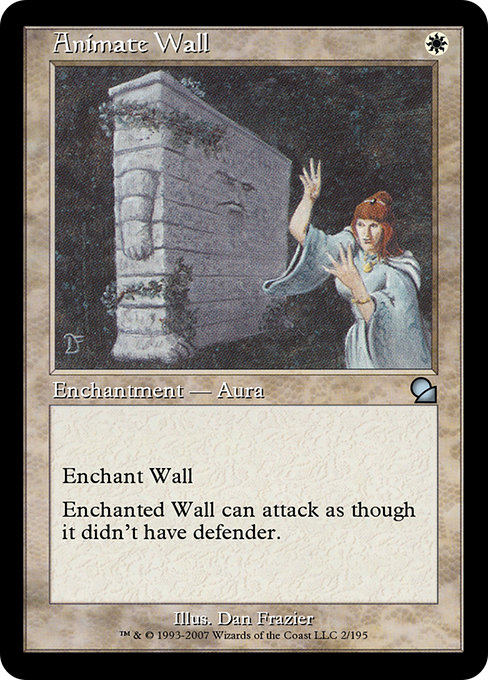
Still, there’s something appealing about limiting yourself to what you open—there’s a reason Sealed Deck has survived economic busts, global pandemics, and the introduction of Set and Collector boosters. There’s a desire for the egalitarian in all human endeavors, even card games, and so you see playgroups restricting themselves in formats like Pauper, Penny Dreadful, and even Limited.
Last summer, I spent a week camping in California, where a fellow enthusiast brought a battle box of Pauper Commander decks—unsleeved, battered and border-beat, riffle-shuffled into the texture of linen. These were not tuned lists, with Ash Barrens and Lotus Petal, but sixteen Mountains, sixteen Islands, and maybe a tapland or two if you were lucky. Played on picnic tables by the light of the bug zapper, they felt like the decks I first built out of a stack of Tempest boosters and cannibalized preconstructed decks.
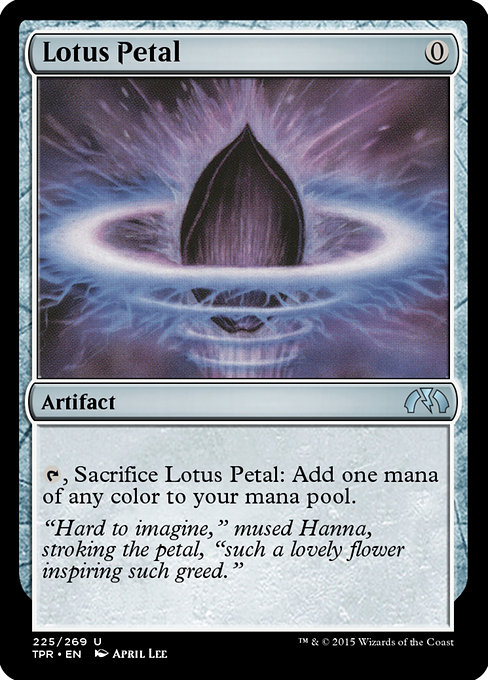
I thought of that week of Pauper Commander as I dove into Lord of the Rings: Tales of Middle-Earth Limited—the most interesting Limited formats are ones where the commons define the way the game operates, whether that’s the Myr of Mirrodin or the Signets of Ravnica ramping the winning decks to four mana on turn three or Khans of Tarkir’s Morph creatures smoothing the format’s demanding mana. Lord of the Rings, despite the flashy mythics and Modern power level, is no different—cards like Mushroom Watchdogs and Treason of Isengard are the cards you see most, and are the cards that have the greatest impact over the most number of games.
Those of us who play Constructed have a different experience—Modern grinders snap-buying their set of The One Ring and Commander players hoping to open the alt-art, foil version of their pet general may not be able to name a common outside of Mirkwood Bats. Yet, per Wizards’ player research, there are Magic players who never open more than a handful of boosters, and so their collections are going to be mostly commons.
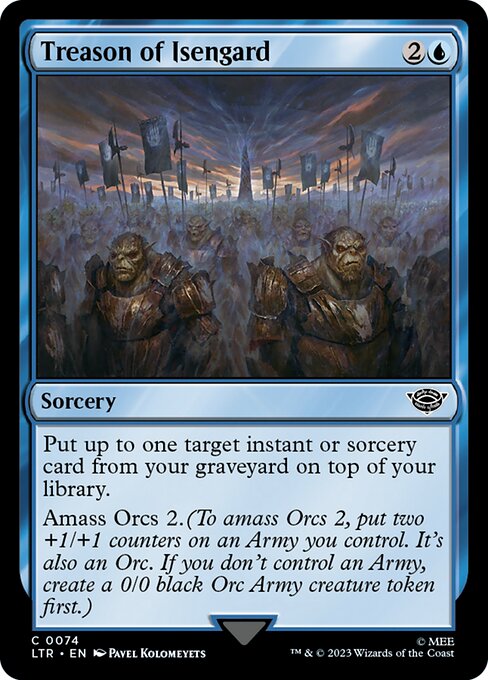
It’s no secret now that Black is a touch overpowered in Lord of the Rings—Black is hard to calibrate for Limited, as it does effectively everything you want in that format: kill creatures, recur bombs, and draw towards your game-ending cards. Mordor Trebuchet and Mirkwood Bats, so long as you can keep a steady stream of Orcs or Goblins, presents inevitability, with an easy four damage coming to one player per turn and some splash damage to every opponent. I’ve closed out games with Ballistic Boulders and have become very enamored of Mordor Muster, the best Dusk Legion Zealot yet printed.
In War of the Spark, Amass was potent, but mostly on the back of Aven Eternal; in Lord of the Rings, the Red/Black Amass deck can curve out before your opponent has the chance to catch up. It led me to see if an Amass Orc deck was feasible in Pauper Commander. The limited Commander format, due to an original lack of Legendary options at the uncommon slot pre-Dominaria, allows any uncommon as a Commander. While non-Legendary options exist for the deck, including Munitions Expert, Murderous Redcap, and Blazing Hellhound, I’m going with Mauhúr, Uruk-hai Captain, just because it feels more like original Commander for me to have a Legendary Creature in the command zone. The Winding Constrictor-esque ability is also a bonus when you’re Amassing an Army, and is especially fun with forgotten Tempest common Sadistic Glee.
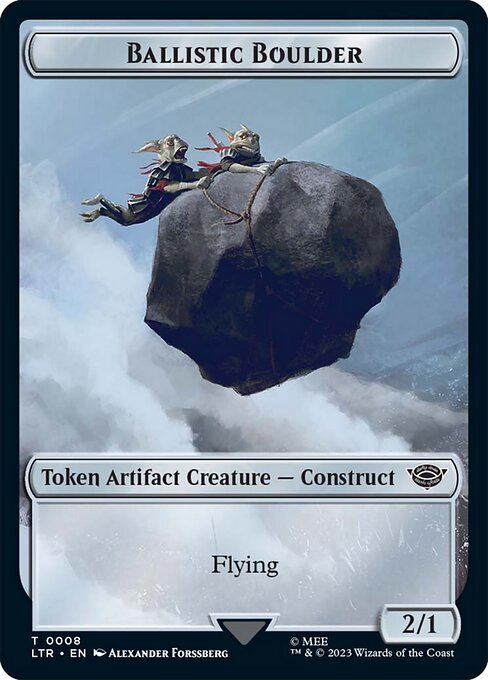
We’re not going to have to debase ourselves by playing Brassclaw Orcs, luckily, now that we have Tales of Middle-Earth. Much as the sun-averse and cowardly Orcs were leveled up into the diurnal and belligerent Uruk-hai through Saruman’s eugenics program, we have a new class of Orcs that are a class far above the old Orcish Veteran. The temptation is to load up the deck with Goblins, but this isn’t a Goblin deck—it’s an Orc deck. Brightstone Ritual and Sparksmith are all well and good, but those decks have been around for twenty years—now is the Age of the Orc. I couldn’t resist Goblin Grenade, though, and Grenzo’s Cutthroat has seriously overperformed.
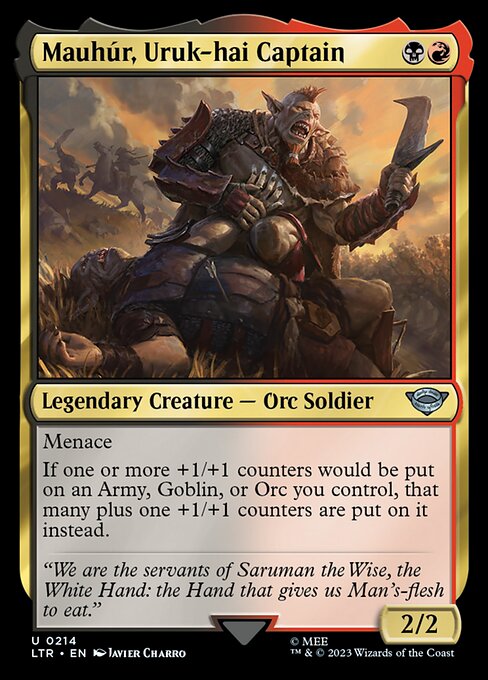
Commander: Mauhúr, Uruk-hai Captain
Impulsive Pilferer
Grim Initiate
Changeling Outcast
Cauldron Familiar
Carrion Feeder
Lazotep Reaver
Carrier Thrall
Gluttonous Slug
Adder-Staff Boggart
Orcish Hellraiser
Grenzo’s Cutthroat
Dark-Dweller Oracle
Body Dropper
Blood Aspirant
Iron Bully
Mordor Trebuchet
Dunland Crebain
Venomous Changeling
Blisterstick Shaman
Orcish Bloodpainter
Hangar Scrounger
Mirkwood Bats
Novice Dissector
Goblin Assault Team
Emrakul’s Hatcher
Cirith Ungol Patrol
Invading Manticore
First-Sphere Gargantua
Gloomfang Mauler
Unearth
Sadistic Glee
Sticky Fingers
Beamtown Beatstick
Tormented Existence
Goldvein Pick
Arcane Signet
Rakdos Signet
Fellwar Stone
Golden Egg
Lembas
Deadly Dispute
Mordor Muster
Orcish Medicine
Essence Infusion
Rite of Consumption
Subtle Strike
Unexpected Fangs
Bitter Reunion
Spawning Breath
Brood Birthing
Ancestral Vengeance
Honor the God-Pharaoh
Brimstone Volley
Swarming of Moria
Foreboding Fruit
Butcher’s Glee
Grave Birthing
Big Score
Deadly Derision
Contact Killing
Essence Feed
Cave of Temptation
Command Tower
Bloodfell Caves
Geothermal Bog
Ash Barrens
Heap Gate
Rakdos Guildgate
Black Dragon Gate
Basilisk Gate
Cliffgate
Barren Moor
Forgotten Cave
14 Mountain
12 Swamp
Changeling Outcast is our MVP here–as both an Orc and an Army (and a Brushwagg and an Eye and a Sliver and so forth), the little one-drop can be Amassed upon and remain unblockable, as can the other few Shapeshifters. The combination of Rite of Consumption and a beef monolith has been ending games for almost twenty years in Pauper (and, at one point, in a Limited combo with Quillspike and Devoted Druid), and so it has a home here once we’ve Amassed a 15/15 Orc Army.
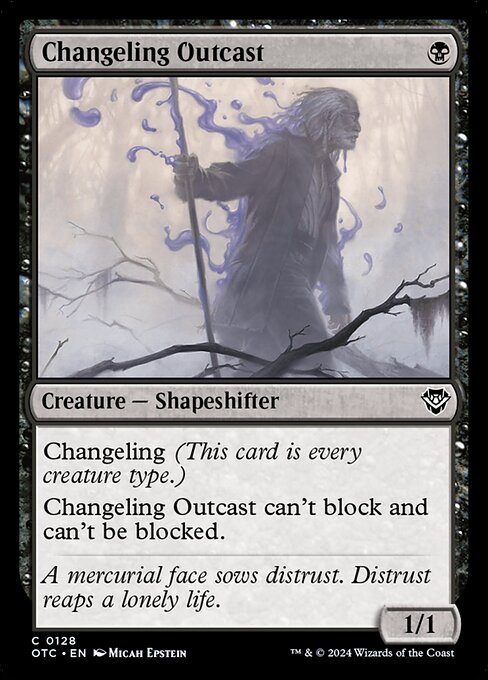
The catch-22 of Amass is that, should you lose the ability to attack or block with the Army, say with a Pacifism, you will continue to impotently Amass and be unable to send them into battle—luckily, we can take a page from Saruman and provide a few simple ways to sacrifice our Army so that we can rebuild. Mirkwood Bat is closer to a magpie, judging by how well it intersects with Treasure, but it also triggers off of sacrificing an Army to Orcish Bloodpainter or the newly reprinted–and rarity-shifted– Blood Aspirant. My interest is piqued any time there’s a significant downshift, particularly when a rare drops to common—it’s infrequent that this occurs, but we’re running recent downshift Dark-Dweller Oracle as a sacrifice outlet and a quasi-card-advantage engine.
There’s a variant of this deck that could be closer to Modern’s Rakdos Scam archetype, with all the Undying Evil variants and an Aristocrats-like strategy, but I’m more into making the biggest Orc Army I can rather than sacrificing skirmish parties. The Eldrazi subtheme is a little suspect–too diluted by the vagaries of the format to present a path to victory–but the ability to sacrifice a passel of Spawns and Scions with a Mirkwood Bats out is too tempting to resist. Same with the minor Food subtheme–the quasi-combo of Cirith Ungol Patrol and Cauldron Familiar isn’t quite Familiar and Samwise Gamgee, but it does engineer a semi-Phyrexian Arena.
Magic has a large enough cultural footprint, particularly post-pandemic in the online community, that the awareness barrier is thin. It’s likely, judging from Wizards’ marketing strategies with the set, that Tales of Middle-Earth is meant to serve as a standalone set; that is, thousands of Magic players will never purchase a Standard-legal set, but will instead play Tales exclusively as something closer to a traditional board game than the constantly fluctuating standards of tournament Magic.
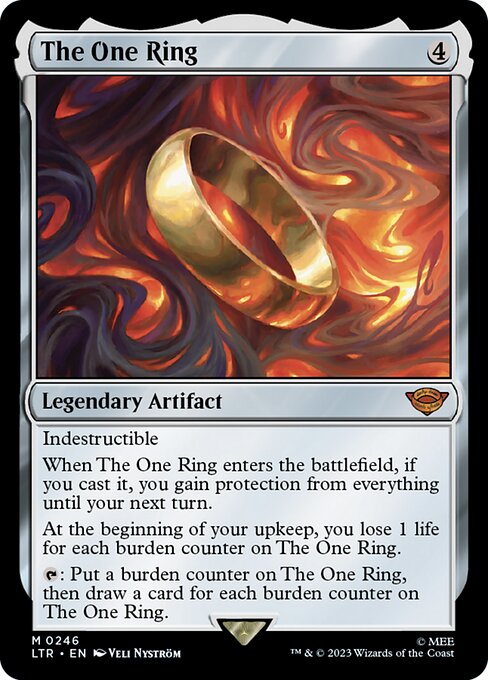
If you’re reading this, you’re part of the sliver of enfranchised players—per Wizards’ research, the majority of players never move beyond a casual environment. This means most people who play Magic will never walk through the doors of their local game store, aren’t aware that multimillion dollar businesses exist to buy and sell single cards, or will never purchase a product outside of their local big-box retailer or Amazon. Those players don’t min-max their decks based on what people log on EDHREC, don’t drop a quarter of a mortgage payment on a set of The One Ring, don’t pay attention to the 3,500 cards, some Commander exclusives, that get printed each year.
Pauper Commander is, as the name implies, budget-friendly, which often means friendly to new players. Certainly, you can spend a minor fortune getting your preferred basics and Secret Lair versions of your mana rocks and optimizing your deck with Lotus Petal and Rhystic Study, but it’s also possible to build a functioning Pauper Commander deck out of draft leavings. For my Lord of the Rings box, I’m setting a loose budget of $20 per deck—I don’t mind supplementing with some of my personal collection, but I want to stick to that target as it’s my personal threshold for “amount of money I don’t mind losing” if I give the pilot their deck at the end of the session. It makes the stakes lower and the transiency of it appealing–these decks may get either retired once they’re too ragged to shuffle or when a new player takes a shine to The Mouth of Sauron. But whether you’ve been playing for a day or a decade, it’s worth paying attention to the most common of your cards and seeing the potential in even the most parsimonious strategies.
Rob Bockman (he/him) is a native of South Carolina who has been playing Magic: the Gathering since Tempest block. A writer of fiction and stage plays, he loves the emergent comedy of Magic and the drama of high-level play. He’s been a Golgari player since before that had a name and is never happier than when he’s able to say “Overgrown Tomb into Thoughtseize,” no matter the format.

